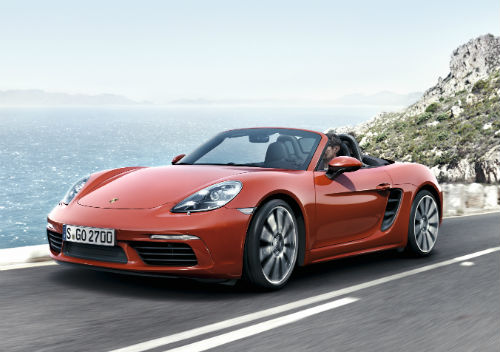2016 Boxster: Flat to the phwoar
/Fewer cylinders, more fun: That's the implied message associated with the updated Boxster here mid-2016.
BELT-tightening is occurring throughout the Volkswagen Group brands as the parent faces up to a a billion dollar cost of making good on diesel-gate, but it’s not the reason why the smallest Porsche sports car has cut down on its cylinder count.
Dropping the charismatic, 2.7- and 3.2-litre naturally aspirated flat-sixes from the Boxster for a turbocharged flat-four in 2.0- and 2.5-litre capacities might sound like a penalty but isn’t.
The ‘less is more’ swap delivers a big lift in energy and enhances efficiency as well.
The new engines come in freshened packaging and with a new name; the models coming in around June – easily identified by taking a whole new frontal styling – are identified as 718 Boxsters, the latter numeric having past history in Porsche-dom: The brand ran 718 open sports car in endurance events, notably the Le Mans 24-hour and the Targa Florio road race, back in the 1950s and ‘60s.
Straight after Germany confirmed the 718 is incoming and will be revealed officially at the Geneva motor show on March 3, the New Zealand distributor – part of the European Motor Distributors’ family –identified that both the entry 2.0-litre, called simply the 718 Boxster, and the more powerful 2.5-litre ‘S’ edition, will be available here “from mid-year.”.
While no prices have been announced, it would seem probable the models will carry a slight premium over the outgoing Boxster and Boxster S, as the updates also deliver specification changes.
The centerpiece of the new model series is the newly developed turbocharged four-cylinder flat.
The 2.0-litre develops 220kW and 380Nm while S produces 257kW and 420Nm; which means power is up by 25kW for both variants, while torque is hugely improved, not least for the entry mill. It generates another 100Nm over the 2.7 while the new top engine has 60Nm over its predecessor.
Acceleration has also improved with the Boxster getting to 100kmh from standstill in 4.7 seconds – 0.8 seconds faster than its predecessor when fitted with the Doppelkupplungsgetriebe (PDK) six-speed automatic dual-clutch transmission and Sport Chrono Package.
With the same equipment, the Boxster S does the dash in 4.2 seconds – 0.6 seconds quicker than the six-cylinder version.
Top speeds remain in keeping with the brand image; the base car topping out at 275kmh and the S finding another 10kmh beyond that.
So there’s the energy side of things.
Efficiency? Porsche says both models have fuel economy improvements of up to 13 percent for the PDK gearbox models; that means the entry mill has a NEDC fuel consumption figure of 6.9 L/100 km (1.0 L/100 km less than previous) and the 2.5-litre consumes just 7.3 L/100 km (0.9 L/100 km less).
The engines might also appeal for their flexibility. The 2.0-litre engine’s maximum torque is available from 1950rpm to 4500rpm. The 2.5-litre engine has maximum muscularity from 1900rpm to 4500rpm. The outgoing entry six cylinder required winding out to 4500rpm to hit peak torque while the 3.2-litre needed to held at 4500-5800rpm to create top twist.
The 2.5 has a special ingredient in a variable-vane turbocharger, allowing for higher boost levels without compromising low-speed performance or efficiency, Porsche says.
The most obvious visual changes are at the front, with larger air intakes at a flatter angle than before, as well as thinner LED light strips and sharp new headlights. The revisions don’t stop there, though: There are bigger vents on the sides, larger 19-inch alloys and sleeker door handles, too while, at the back, the derivatives take redesigned taillights, while the Porsche badge relocates to below the small spoiler. There's also what Porsche calls an 'accent strip' that runs between the lights to add to the illusion of the rear end having become wider.
Little has changed inside, but there are some new air vents, a new steering wheel and the clock as been moved higher on the dashboard. There's Porsche Communication Management as standard, which adds mobile phone connectivity, a powerful sound system and the ability to add Apple CarPlay and other online services.
Options? It’s a Porsche so … naturlich! The key option is Porsche Active Suspension Management, which lowers the car by 10mm in respect to the entry car and by 20mm on the S. Porsche says the active chassis parts have been tuned for better comfort and responsiveness, too.
As well as the Normal, Sport and Sport Plus modes, there's also now an Individual setting and a new Sport Response button on the dash - this makes the engine and gearbox even more responsive. Just like many other Porsche models, there's an optional Sport Chrono Package too.
No mention is made of the Boxster's Cayman twin, which has shared much of the convertible's underpinnings and equipment, but in a fixed-top coupe package.
The iconic 911 has already adopted an all-turbo line-up of engines, with only the hardcore RS sticking with natural aspiration for its induction.

















